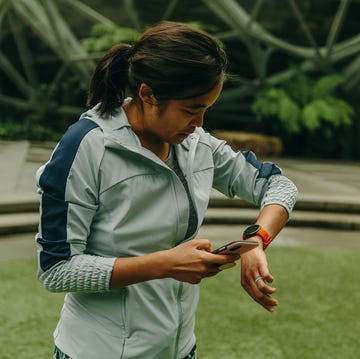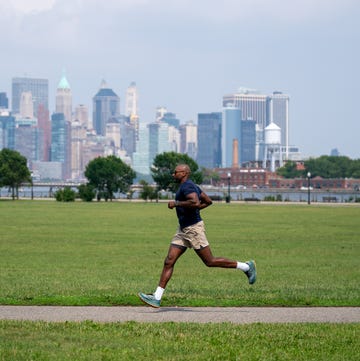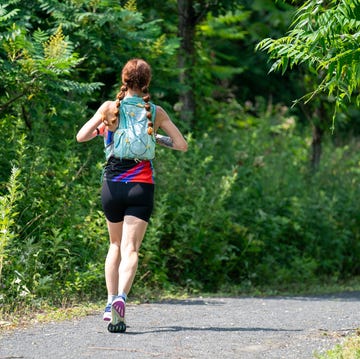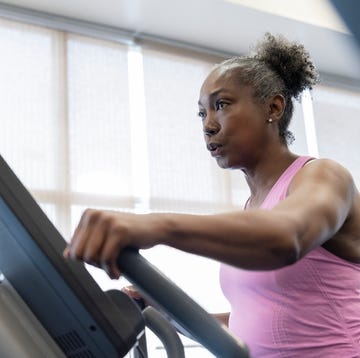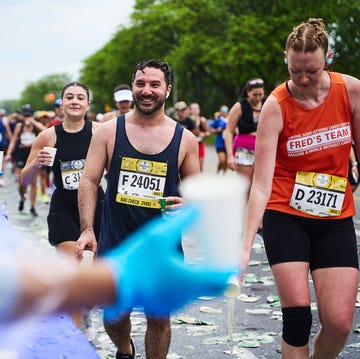Distance running is a long-term game, and to stick with the sport (or even to start) in your golden years, you’ll need some extra motivation. For many runners, that motivation comes from competition, like the National Senior Games, which has the motto: It’s never too late to get active.
The National Senior Games, which started in the 1980s, is a biennial competition hosted by the National Senior Games Association. It brings together athletes ages 50 and older to compete in 25 different sports, including road races and track and field events. To compete, athletes must place top four in their age division on a state level the year before.
So what’s the secret to getting to that level and staying active and competitive as you age? For answers, we tapped a few of this year’s top competitors to share how they got started running, and what inspired them keep up with their training—and their competition—this season. Here’s their best advice.
Tom Lough, 83, Round Rock, Texas
I am a United States Army veteran who competed in the 1968 Olympics in the modern pentathlon, where I placed 28th individually and fourth with my team. The sport was fairly new at the time, and many people were unfamiliar with it. To be honest, I had only learned of it a couple of years prior to that.
Largely inspired by the triathlon, the modern pentathlon involves running, swimming, horseback riding, fencing, and pistol shooting.
Nearly 60 years later, I still have the desire to compete, which is why I have participated in the Senior Games nearly every year since I learned about the competition in 2007.
The Games offers just the motivation I need to stay in shape. It supports my cardiovascular health, which is crucial, considering I now have a pacemaker.
In preparation for this year’s event, I decided to add pistol shooting with a laser gun to my runs as a way to make my workouts more interesting. My typical laser run consists of shooting the laser pistol until I hit five bull’s-eyes, then running a 600-meter loop around my neighborhood. I repeat this several times, until I’ve completed six rounds of shooting and run just over two miles.
Throughout my training, I also visited my local track a couple of weekends to run time trials and practice my race pace (about an 8:00 pace), and finishes, particularly working on leaning into the finish line with my chest.
These workouts led me to a 6th place finish in the 800 meters with a time of 4:03 and 11th place in the 1500 meters, finishing in 9:22.
You’re going to have good runs and bad runs, and on those bad runs you’re going to need a little extra internal motivation. This is why finding a way to make running more enjoyable is important: When it gets hard, you can focus on the parts you love most about running, rather than the hard part of the workout. For me, that’s been bringing elements of the pentathlon back into my training.
Kathryn Foucar, 75, Albuquerque, New Mexico
When I started competing in the National Senior Games in 2000 at 50 years old, running wasn’t my main focus—team sports were. I was focused on basketball and soccer, though I wasn’t particularly good at either sport. I just enjoyed being on a team. But running did have a purpose in my life, mainly as a way to maintain fitness in between sports.
My first year competing on the basketball team, I broke my ring finger and pinky while trying to retrieve the ball, and so I quit the team. That’s when I made the decision to switch from basketball to running, and I’ve proven I’m pretty good at it.
Fueled by my competitive spirit, I made it my goal to set a new record for women ages 75 to 79 in the 5K and 10K. When I checked the previous records, I had a feeling I could run just as fast as or even faster than the women before me. I also knew that I could run faster because I had an altitude advantage going from Albuquerque to Des Moines.
I accomplished that goal this year, crossing the finish line for the 5K in 25:28, smashing the current record set in 2015 by Rita Kilker, who finished in 28:04. I set the new record for the 10K, too, with a time of 55:19.
To achieve these fast times, I developed my own game plan to include a mixture of running, swimming, rowing, cycling, and strength training with the primary goal of strengthening muscles in my legs. This was very important to me considering I’ve experienced knee problems over the past few decades and also because running-related injuries are common for older adults.
I exercised seven days a week throughout my training. On Tuesdays and Thursdays, I’d start my 2.5 hour workout with an hour of swimming (alternating between freestyling and using a kickboard). Then I would go run anywhere between 2.5 to 3.5 miles, fartlek style switching between easy, intermediate, and hard paces. I’d finish my workout at the gym with a mix of core and leg exercises.
My long-run days were Saturdays with the Albuquerque Road Runners Club, and I’d usually complete anywhere between six and nine miles with them.
We have three generations of runners in our family: My husband and I, my two sons and their wives, and two of my three grandchildren. We run local races as a family, and we hope to run BOLDERBoulder in 2026 to celebrate our 50th wedding anniversary.
Susan Rollins, 67, Johnson City, Tennessee
My relationship with running began when I was a freshman at Davidson College in North Carolina nearly 50 years ago. I ran the cake race, an annual school tradition that dates back to the 1930s. Students take home a cake of their choice after crossing the finishing line of the 1.7-mile race. My freshman year in 1976, I came in first for the women.
My school didn’t have a women’s cross-country team until 1977, my sophomore year. I joined the team that year and I’d run on and off as a way to relieve stress during my years as an undergrad, medical student, and resident.
I competed in my first National Senior Games in 2015. That year, I set the record for women ages 55 to 59 in the 1500 meters, finishing with a time of 5:23. Fast forward 10 years, and this summer I placed second in the mile with a time of 5:56, fifth in the 5K with a time of 20:39, and third in the 10K with a time of 43:36. I finished first in my age group (65 to 69) in all three events.
For the past 25 years, I’ve been told by physicians that I shouldn’t be running because of knee problems (I’ve had four knee surgeries including a partial knee replacement). I also have rheumatoid arthritis which is why it’s important for me to limit the impact on my joints while building my aerobic capacity. But I still run because I believe in the physical therapy saying: “Motion is lotion.”
Cross-training was my secret to success this year. In the weeks leading up to the Games, I spent most of my time at the gym strength training and swimming, training three days a week. My strength-training routine focused on balance, core, and flexibility exercises. I swam for an hour at least twice a week. Keeping this routine is how I was able to regain the strength in my knee, and reduce my pain.
Focus on cross-training as a way to strengthen your whole body from head to toe. Keeping your joints mobile is key. As a retired pathologist, I was used to standing hunched over, performing biopsies, and it has taken me quite a while to try to regain my mobility in certain areas. This is why I find it important to do a combination of activities, rather than just running, and that includes swimming, biking, hiking, yoga, or strength training.
Jeffrey Brune, 60, Omaha, Nebraska
When I was younger, I always saw running as a means to an end. You run to catch a football, kick a soccer goal, dribble a basketball down the court, or win a cross-country meet. Now that I’m older, I still have a similar point of view, but the end is to connect with nature, meet other runners, travel to different places, and of course, stay in shape.
I’ve moved around a bit throughout my life, but I’ve always managed to connect with a run club in my community and make new friends. My friends and my wife have always encouraged me to do my best in running and compete in races.
I ran my first marathon, the Marine Corps Marathon, in 2018. And I’ve completed about 80 races—a combination of 5Ks, 10Ks, half and full marathons—between my first marathon and now.
I learned about the Games from a friend, shortly after I moved to Omaha, Nebraska from Grand Junction, Colorado in 2022. That same year, I ran the 5K and 10K at the Nebraska Senior Games.
This year, I competed in my first National Senior Games and to prepare, I used an app called Run Coach. This app mapped out all of my run workouts, so I didn’t have to worry about it. Each week, I completed a maintenance run, speed run, long run, and cross-trained on separate days. I also practice an advanced core workout from Fitness Blender at least two times a week.
To my surprise, I came first place in the 5K and 10K. I remember running with a couple of guys during the 5K for the first kilometer until we reached the hill. I love running hills, so I broke away from the group. Then it was just me and the bike in the front until I crossed the finish line at 17:23 (a 5:36 pace).
Not only did I come in first place, but I also broke the record for my age group (60 to 64 years old), and set a personal record. What was even more shocking: I ran faster than I did as a cross-country runner in college, when my personal best was 28:21 in the 5-miler (a 5:40 pace).
I didn’t think I was capable of running that fast at 60 years old, so I’m proud of my body’s capabilities. Being able to set a new record at the National Senior Games proved to me anything is possible if you stick with your training and prioritize recovery.
Try to run with other people at least once a week, if you can. Being in a community of people gives you the opportunity to talk to other runners about anything from race strategy to injury prevention and everyday life. Also, when you’re running and talking with someone it helps make running feel easier and more enjoyable.

Monique LeBrun is a health and fitness editor who is based in Easton, Pennsylvania. She covers a wide range of health and wellness topics, with a primary focus on running performance and nutrition. Monique is passionate about creating content that empowers runners to become the best versions of themselves. As an avid runner and parent, she loves spending time outdoors with her daughter, who often accompanies her on weekend runs as her personal mini run coach.






